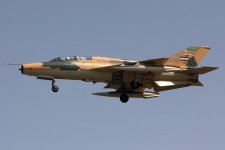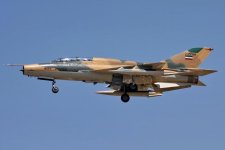Navigation
Install the app
How to install the app on iOS
Follow along with the video below to see how to install our site as a web app on your home screen.
Note: This feature may not be available in some browsers.
More options
Style variation
You are using an out of date browser. It may not display this or other websites correctly.
You should upgrade or use an alternative browser.
You should upgrade or use an alternative browser.
Iranian Air Force (IRIAF/IRGC-ASF) | News and Discussions
- Thread starter Persian Gulf
- Start date
Fatman17
THINK TANK: CONSULTANT
- Apr 24, 2007
- 37,383
- 43,757
- Country of Origin

- Country of Residence

TEHRAN FLEXES ITS MUSCLES
- Aviation Features
- TEHRAN FLEXES ITS MUSCLES
By report: Babak Taghvaee 4th January 2018
FEATURE
For the third consecutive year the Islamic Republic of Iran Air Force (IRIAF) held its ‘Devotees of Velayat’s Territory’ exercise in Isfahan, in the center of the country.

This image: A rare outing by the 31st TRS saw this single RF-4E participating in the ‘Devotees of Velayat’s Territory’ exercise. Note that it carries an old AN/ALQ-101 jamming pod.
Abbasi
THE 2017 EXERCISE, which took place on October 31 and November 1, saw participation by 57 fixed-wing aircraft and one helicopter from eight tactical fighter bases and two tactical transport bases. The objective was not only to increase personnel readiness but also to test new weapons and tactics. As in previous years, the IRIAF fighterbombers practised combat tactics in a jamming environment, but this time missions were flown both day and night.
The main participants were 43 fighters, comprising seven F-4E Phantom IIs, five F-5E Tiger IIs, five F-5Fs, three F-5E Saeghes, an F-5F Saeghe II, two F-7Ns, three FT-7Ns, six F-14A Tomcats, three MiG-29UBs and three Su-24MKs. Among these, five F-4Es from the 3rd Tactical Fighter Base (TFB.3) at Nojeh (Shahrokhi), and five F-7N/FT-7Ns and six F-14As from TFB.8 at Babaiee (Khatami), took part from their home bases. All other fighters were deployed from their bases to TFB.8 in Isfahan on October 28-29.
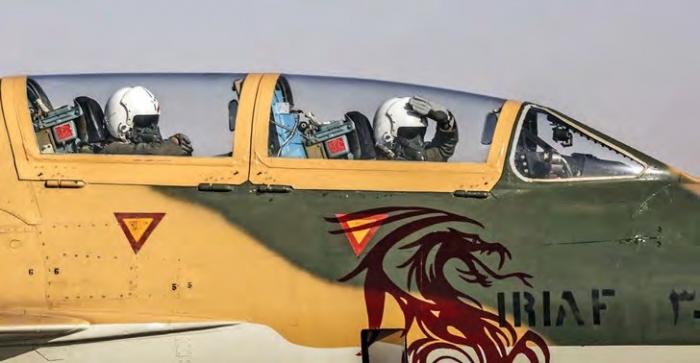
FT-7N serial 3-7725 flew both ground attack and interceptor missions.
Akbar Tavakkoli
TFB.8 was a suitable base for guest F-4Es, Saeghes and F-5E/Fs, but was less well equipped for the Russian-made MiG-29s and Su-24s. Two Il-76TDs and three C-130E/H Hercules of the 1st and 7th Independent Tactical Transport Bases were used to transport ground equipment and crews as well as armament and spare parts for the ‘Fulcrums’ and ‘Fencers’ to Isfahan from Tehran, Tabriz and Shiraz.
Throughout the exercise one of two airworthy IRIAF KC-707s (Boeing 707-3J9C) and the sole airworthy KC-747 (Boeing 747-131F) tanker were employed to provide aerial refueling support. One of two EC-707s (Boeing 707-3J9Cs) and an RC-130H electronic intelligence/signals intelligence (ELINT/SIGINT) aircraft were used as airborne command posts as well as for monitoring airspace around the exercise to detect any foreign reconnaissance aircraft or drones. A Dassault Falcon 50EX ‘Saye’ (‘Shadow’) electronic warfare (EW) aircraft was used to provide a jamming environment for the participants. On stand-by at TFB.8 for search and rescue was an IRIAF Bell 214C helicopter, serial 4-9444.
ISLAMIC REPUBLIC OF IRAN AIR FORCE

Live Mk80 iron bombs are loaded on F-4E triple ejector rails.
Abbasi

The F-5s and Saeghes flew with 19-tube LAU-3/A launchers for 2.75in (70mm) training rockets.
Mhosen Ranginkaman
First day of training
On the first morning, participants practised for the air-to-air and airto- ground missions that would be carried out the next day. Three F-4Es from TFB.6 Yassini each flew with a TGM-65A Maverick captive air-launched training missile (CATM). The crew of a fourth F-4E belonging to TFB.3 dropped a GBU-87/B Ghased TV-guided bomb, while a TFB.7 Su-24MK launched a Kh-25ML (AS-10 ‘Karen’) laser-guided airto- ground missile.
At the same time, two MiG-29UBs participated in dissimilar air combat training (DACT) missions with a pair of F-14As that were providing top cover for the F-4s, F-5s and F-7s. Two F-5Fs also undertook DACT with two F-4Es. Pairs of F-7Ns, F-5E/Fs, and Saeghe I/IIs honed their rocketry skills with 2.75in (70mm) training rockets fired from 19-tube LAU-3A launchers, while four each of F-4Es and F-5E/Fs delivered Mk81 and Mk82 training bombs.
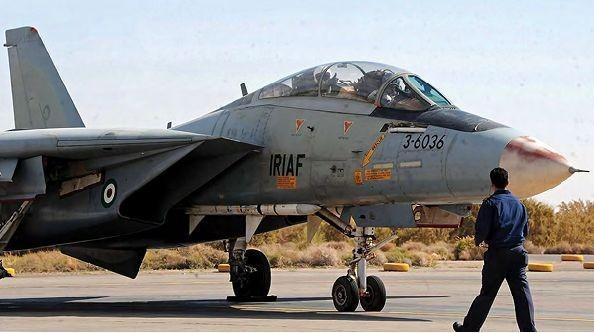
F-14A Tomcat serial 3-6036 taxiing with a pair of live AIM-7E Sparrows attached and live AIM-9Js out of shot. It was not taking part in the exercise but was on QRA at Isfahan.
Hamed Ataei
Night missions
The combat phase of the exercise started on the evening of October 31, after intelligence had been gathered by an RF-4E of the 31st Tactical Reconnaissance Squadron forward-deployed to TFB.8, and by three Mohajer-3 and Mohajer-4 unmanned aerial vehicles (UAVs). The video footage and photos were analyzed and targets were selected on a 1:1-scale air base at Anarak, a gunnery and EW range near Isfahan. The night bombing mission involved two Su-24MKs and six F-4Es, with top cover from two F-14As each armed with pairs of AIM-9J infrared- guided air-to-air missiles (AAMs) and AIM-7E-2 semi-active radar-guided AAMs. That night the F-4Es bombed their targets using Mk81 iron bombs, with the aid of flares launched by other F-4Es, while the Su-24MKs dropped their 100kg (220lb) FAB-100 bombs with the assistance of their on-board targeting system equipped with an infra-red camera.

Fatman17
THINK TANK: CONSULTANT
- Apr 24, 2007
- 37,383
- 43,757
- Country of Origin

- Country of Residence

61st TFS F-4Es carry a distinctive shark’s mouth. This one totes a captivecarry TGM-65A Maverick.
Ehsan Jazini
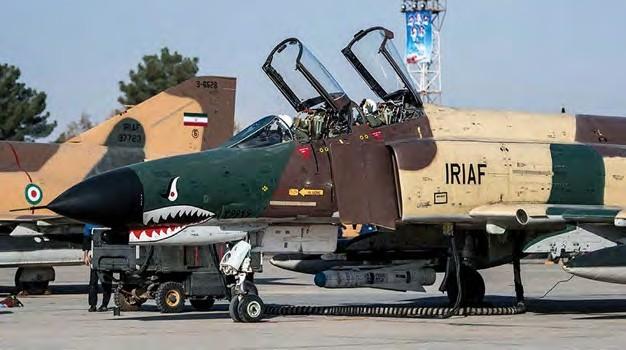
20mm ammunition is loaded into the F-5E’s singlebarrel M39A2 cannon.
Mhosen Ranginkaman
PARTICIPANTS IN THE ‘DEVOTEES OF VELAYAT’S TERRITORY’ EXERCISE

All missions were carried out in a jamming environment created by the Falcon 50EX. On returning to their bases, the TFB.3 F-4Es and the two F-14As received fuel from KC-707 serial 5-8304, one of two flyable examples in the fleet. This tanker was overhauled by Iranian Aircraft Industries (IACI) and reentered IRIAF service in June 2017. After refueling at an altitude of 997ft (304m) the Tomcats returned to the exercise area to provide top cover, or high-value asset combat air patrol (HAVCAP), for the KC-707 and a C-130H flying from TFB.1, the latter performing a night cargo air-drop.
Second day
On November 1 the participants used live air-to-air and air-to-ground munitions including precision-guided bombs and missiles, ‘dumb’ bombs, rockets and guns. Targets were engaged on the 1:1-scale airfield at Anarak. At the same time, the EW Falcon provided jamming while the EC-707 was again engaged as an airborne command post.
Pilots of TFB.9’s F-4Es who had employed precision-guided munitions in previous exercises only carried out toss-bombing and level-bombing using Mk82 and Mk83 live dumb bombs, while two F-4Es from TFB.6 and a third example from TFB.3 launched three AGM-65A Mavericks against three moving targets. These objectives been detected by IRIAF Mohajer-3 and Mohajer-4 UAVs flying over the exercise area. Another F-4E flying from TFB.3 dropped a GBU-78/B TV-guided bomb on a large target. Thousands of feet above the F-4Es, two F-14As providing top cover were engaged in air combat with two MiG-29UBs flying as aggressors.
As well as the Phantoms, two Su-24MKs launched two Kh-25ML laser-guided missiles at their targets. Then two F-5E Saeghes, two F-5E/Fs, and two FT-7Ns dropped Mk83 bombs on their objectives. After these bombing missions, two F-7Ns, two F-5E/Fs, an F-5E Saeghe and an F-5F Saeghe II, each armed with two to four LAU-3A rocket launchers fired a total of 171 2.75in (70mm) rockets in two passes. They returned and carried out gun strafing on ground targets during another two passes.
ISLAMIC REPUBLIC OF IRAN AIR FORCE

A 72nd TFS Su-24MK gets airborne toting two Kh-25MT TV-guided missiles.
Hamed Ataei

A young F-4E pilot completes paperwork prior to heading out to drop a live Mk80 slick bomb.
Akbar Tavakkoli

Captive-carry TGM-65A Mavericks enabled F-4E crews to practise AGM-65A launches.
Ehsan Jazini
Two Karrar targets were launched from a nearby drone airfield. They were shot down by two AIM-7E-2 AAMs launched by an F-4E and an F-14A. Meanwhile, F-5F serial 3-7167 launched a TDU-11/B infra-red target that was downed by an R-73E (AA-11 ‘Archer’) short-range AAM, fired by the pilot of MiG-29UB serial 3-6306 over the Anarak range.
Under the top cover of two more F-14As, each armed with two AIM-9Js and two AIM-7E-2s, three C-130E/Hs conducted their missions. C-130E serial 5-8507 flying from TFB.1 Lashgari at Mehrabad International Airport, Tehran, dropped two Mk84 2,000lb (907kg) unguided bombs on fighting positions and hideouts belonging to imaginary terrorists of the so-called Islamic State (IS). Then C-130H serial 5-8552 operating from Tehran air-dropped cargo including weapons and food supplies. Airborne commandos from the Islamic Republic of Iran Army Ground Forces’ 55th Airborne Brigade rounded proceedings Off by using a C-130E flying from TFB.7 Dowran at Shiraz for a parachute jump.
After the exercise, four F-14As received fuel from KC-707 serial 5-8304, and two of the Tomcats were used to provide HAVCAP for KC-747 serial 5-8103, which in turn refueled four F-4Es from TFB.3 on their return to their home base at Hamedan. The other two Tomcats escorted six Russian Aerospace Forces Tu-22M3 bombers, which had flown from Mozdok air base in southern Russia in order to bomb IS targets in Deir ez-Zor, Syria.

Ehsan Jazini

20mm ammunition is loaded into the F-5E’s singlebarrel M39A2 cannon.
Mhosen Ranginkaman
PARTICIPANTS IN THE ‘DEVOTEES OF VELAYAT’S TERRITORY’ EXERCISE

All missions were carried out in a jamming environment created by the Falcon 50EX. On returning to their bases, the TFB.3 F-4Es and the two F-14As received fuel from KC-707 serial 5-8304, one of two flyable examples in the fleet. This tanker was overhauled by Iranian Aircraft Industries (IACI) and reentered IRIAF service in June 2017. After refueling at an altitude of 997ft (304m) the Tomcats returned to the exercise area to provide top cover, or high-value asset combat air patrol (HAVCAP), for the KC-707 and a C-130H flying from TFB.1, the latter performing a night cargo air-drop.
Second day
On November 1 the participants used live air-to-air and air-to-ground munitions including precision-guided bombs and missiles, ‘dumb’ bombs, rockets and guns. Targets were engaged on the 1:1-scale airfield at Anarak. At the same time, the EW Falcon provided jamming while the EC-707 was again engaged as an airborne command post.
Pilots of TFB.9’s F-4Es who had employed precision-guided munitions in previous exercises only carried out toss-bombing and level-bombing using Mk82 and Mk83 live dumb bombs, while two F-4Es from TFB.6 and a third example from TFB.3 launched three AGM-65A Mavericks against three moving targets. These objectives been detected by IRIAF Mohajer-3 and Mohajer-4 UAVs flying over the exercise area. Another F-4E flying from TFB.3 dropped a GBU-78/B TV-guided bomb on a large target. Thousands of feet above the F-4Es, two F-14As providing top cover were engaged in air combat with two MiG-29UBs flying as aggressors.
As well as the Phantoms, two Su-24MKs launched two Kh-25ML laser-guided missiles at their targets. Then two F-5E Saeghes, two F-5E/Fs, and two FT-7Ns dropped Mk83 bombs on their objectives. After these bombing missions, two F-7Ns, two F-5E/Fs, an F-5E Saeghe and an F-5F Saeghe II, each armed with two to four LAU-3A rocket launchers fired a total of 171 2.75in (70mm) rockets in two passes. They returned and carried out gun strafing on ground targets during another two passes.
ISLAMIC REPUBLIC OF IRAN AIR FORCE

A 72nd TFS Su-24MK gets airborne toting two Kh-25MT TV-guided missiles.
Hamed Ataei

A young F-4E pilot completes paperwork prior to heading out to drop a live Mk80 slick bomb.
Akbar Tavakkoli

Captive-carry TGM-65A Mavericks enabled F-4E crews to practise AGM-65A launches.
Ehsan Jazini
Two Karrar targets were launched from a nearby drone airfield. They were shot down by two AIM-7E-2 AAMs launched by an F-4E and an F-14A. Meanwhile, F-5F serial 3-7167 launched a TDU-11/B infra-red target that was downed by an R-73E (AA-11 ‘Archer’) short-range AAM, fired by the pilot of MiG-29UB serial 3-6306 over the Anarak range.
Under the top cover of two more F-14As, each armed with two AIM-9Js and two AIM-7E-2s, three C-130E/Hs conducted their missions. C-130E serial 5-8507 flying from TFB.1 Lashgari at Mehrabad International Airport, Tehran, dropped two Mk84 2,000lb (907kg) unguided bombs on fighting positions and hideouts belonging to imaginary terrorists of the so-called Islamic State (IS). Then C-130H serial 5-8552 operating from Tehran air-dropped cargo including weapons and food supplies. Airborne commandos from the Islamic Republic of Iran Army Ground Forces’ 55th Airborne Brigade rounded proceedings Off by using a C-130E flying from TFB.7 Dowran at Shiraz for a parachute jump.
After the exercise, four F-14As received fuel from KC-707 serial 5-8304, and two of the Tomcats were used to provide HAVCAP for KC-747 serial 5-8103, which in turn refueled four F-4Es from TFB.3 on their return to their home base at Hamedan. The other two Tomcats escorted six Russian Aerospace Forces Tu-22M3 bombers, which had flown from Mozdok air base in southern Russia in order to bomb IS targets in Deir ez-Zor, Syria.

Fatman17
THINK TANK: CONSULTANT
- Apr 24, 2007
- 37,383
- 43,757
- Country of Origin

- Country of Residence

Recently overhauled F-7N 3-7503 taxies out laden with four LAU-3/A rocket launchers and 2.75in (70mm) rockets.
Abbasi

An F-5F is prepped for a mission to fire 2.75in rockets.
Hamed Ataei
ISLAMIC REPUBLIC OF IRAN AIR FORCE

An F-4E with a TGM-65A gets airborne for the first day’s missions.
Hamed Ataei
IRIAF goals
For the IRIAF, the main goal of the exercise was to increase the combatreadiness of almost 100 pilots and navigators, and dozens of ground crews. Other objectives, however, were equally important for the IRIAF commanders. First was to prepare the Chengdu F-7N fighters and their pilots for close air support missions. This work began in summer 2017, when the commander of TFB.8 decided to ready some of his recently overhauled F-7Ns for launching unguided rockets. This was the first time this had been done in the 27 years since the aircraft entered service. Following delivery, the fleet has mainly been used to train advanced flying and weaponry courses.
Iran never procured Chinese-made air-to-ground ordnance for its F-7Ns and FT-7Ns, and instead they were all modified in Iran to use available US-made weapons. They added the capability to launch 2.75in unguided rockets from LAU-3A pods. Upon establishment of the first two F-7 squadrons at TFB.5 Ardestani in Omidiyeh (which were disbanded in 2007), the air base received a huge quantity of LAU-3A rocket launchers but never used them. Following the transfer of all F-7Ns and FT-7Ns from TFB.5 to TFB.8 in 2007, armament stocks were also relocated to the new base. After 10 years, the TFB.8 commander decided to begin familiarizing F-7N instructor pilots in the use of rockets.

The three Su-24MKs that participated.
Mehdi Shamkhani

An F-5F lets rip with a salvo of 2.75in rockets.
Akbar Tavakkoli


F-14A serial 3-6029 returns from an exercise mission.
Ali Khara
Abbasi

An F-5F is prepped for a mission to fire 2.75in rockets.
Hamed Ataei
ISLAMIC REPUBLIC OF IRAN AIR FORCE

An F-4E with a TGM-65A gets airborne for the first day’s missions.
Hamed Ataei
IRIAF goals
For the IRIAF, the main goal of the exercise was to increase the combatreadiness of almost 100 pilots and navigators, and dozens of ground crews. Other objectives, however, were equally important for the IRIAF commanders. First was to prepare the Chengdu F-7N fighters and their pilots for close air support missions. This work began in summer 2017, when the commander of TFB.8 decided to ready some of his recently overhauled F-7Ns for launching unguided rockets. This was the first time this had been done in the 27 years since the aircraft entered service. Following delivery, the fleet has mainly been used to train advanced flying and weaponry courses.
Iran never procured Chinese-made air-to-ground ordnance for its F-7Ns and FT-7Ns, and instead they were all modified in Iran to use available US-made weapons. They added the capability to launch 2.75in unguided rockets from LAU-3A pods. Upon establishment of the first two F-7 squadrons at TFB.5 Ardestani in Omidiyeh (which were disbanded in 2007), the air base received a huge quantity of LAU-3A rocket launchers but never used them. Following the transfer of all F-7Ns and FT-7Ns from TFB.5 to TFB.8 in 2007, armament stocks were also relocated to the new base. After 10 years, the TFB.8 commander decided to begin familiarizing F-7N instructor pilots in the use of rockets.

The three Su-24MKs that participated.
Mehdi Shamkhani

An F-5F lets rip with a salvo of 2.75in rockets.
Akbar Tavakkoli


F-14A serial 3-6029 returns from an exercise mission.
Ali Khara
Fatman17
THINK TANK: CONSULTANT
- Apr 24, 2007
- 37,383
- 43,757
- Country of Origin

- Country of Residence

Another notable achievement was the use of Mohajer-3 and Mohajer-4 UAVs for target detection and live battle damage assessment, a tactic that the IRIAF has learnt from Russian Aerospace Forces combat operations against IS and other terrorist groups in Syria. This allowed the participants to carry out quicker and more precise close support and strike missions against targets detected by the UAVs on the gunnery range.
Finally, the IRIAF showcased its emerging capability to drop bombs from its C-130s. This was in response to an ongoing project of the Islamic Revolutionary Guard Corps Air and Space Force (IRGCASF) that calls for the development of an Iranian equivalent to the US-made GBU-43/B Massive Ordnance Air Blast (MOAB), intended to be delivered from its Il-76TD transports. The main objective is to use the weapon against IS in Syria.

F-14A 3-6078, loaded with a pair of AIM-9Js and AIM-7Es, launches to provide top cover for the F-4Es during night bombing.
Ali Khara
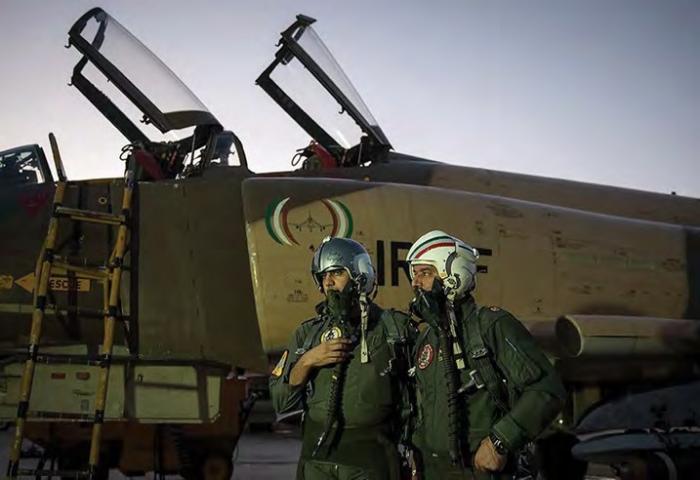
F-4Es of the 31st TFS lay down sticks of bombs on the Anarak range. Ali Khara; An evocative dusk photo of F-4E pilots before a night mission. Ali Khara

Finally, the IRIAF showcased its emerging capability to drop bombs from its C-130s. This was in response to an ongoing project of the Islamic Revolutionary Guard Corps Air and Space Force (IRGCASF) that calls for the development of an Iranian equivalent to the US-made GBU-43/B Massive Ordnance Air Blast (MOAB), intended to be delivered from its Il-76TD transports. The main objective is to use the weapon against IS in Syria.

F-14A 3-6078, loaded with a pair of AIM-9Js and AIM-7Es, launches to provide top cover for the F-4Es during night bombing.
Ali Khara

F-4Es of the 31st TFS lay down sticks of bombs on the Anarak range. Ali Khara; An evocative dusk photo of F-4E pilots before a night mission. Ali Khara

Originally published in Combat Aircraft Journal
GoMig-21
Elite Member
- Oct 16, 2016
- 9,269
- 14,353
- Country of Origin

- Country of Residence

Woah! First time I've seen this incredible "Desert Splinter" camo scheme on the IRIAF's F-14AM Tomcats. From my understanding, this was back in 2013/14 before they switched to the other "mountain camo" scheme I think it was called. Either way, this looks really cool.

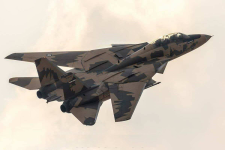
And this 2nd pic is very cool since you rarely see those forward winglets in the LERX pop out fully like that with the variable geometry wings almost folded all the way back to delta. What a beast.


And this 2nd pic is very cool since you rarely see those forward winglets in the LERX pop out fully like that with the variable geometry wings almost folded all the way back to delta. What a beast.
Iranian F-14 Tomcat fighter jets get a modern “splinter” color scheme
Fatman17
THINK TANK: CONSULTANT
- Apr 24, 2007
- 37,383
- 43,757
- Country of Origin

- Country of Residence

A Closer Look At Iranian Air Force Capabilities https://simpleflying.com/iranian-air-force-aircraft/
Likely refer to fighter jets launching long range LACM over Iraq rather than attempting to penetrate Israeli airspace.
Persian Gulf
INT'L MOD
- Feb 19, 2023
- 9,108
- 11,060
- Country of Origin

- Country of Residence

- Thread starter
- #550
pretty risky considering US air supremacy over Iraq
Likely refer to fighter jets launching long range LACM over Iraq rather than attempting to penetrate Israeli airspace.
pretty risky considering US air supremacy over Iraq
US shooting down Iranian fighter jets would be declaration of war.
There is one thing defending Israel passively by shooting down weapons and another thing entirely killing a pilot.
RescueRanger
Moderator
- Sep 20, 2008
- 21,050
- 38,792
- Country of Origin

- Country of Residence

Iran has a formidable missile inventory - but needs to work on building up its air force. Granted that is easier said than done considering the heavy sanctions faced by Iran.
lightning f57
Senior Member
- Feb 27, 2022
- 2,689
- 2,937
- Country of Origin

- Country of Residence

I wonder what game Russia is playing. It can sell the SU-35s, S400's. Putin has a strange relationship with Netanyahu and other Zionists. Its possible he wants to play neutral but it affects Irans ability to acquire aircraft. I would say now is the best opportunity given Russia is massively sanctioned and needing Iranian military support.
Also maybe ALBM that they didn't unveil at parades
Likely refer to fighter jets launching long range LACM over Iraq rather than attempting to penetrate Israeli airspace.
Su-24 is a solid platform for ALBM/aeroballistic missiles with MiG-31
Mr Iran Eye
Full Member
- Feb 6, 2019
- 667
- 769
It is very clear that the IRIAF is hiding things about their forces. One day not far away, we will all discover it
Users who are viewing this thread
Total: 1 (members: 0, guests: 1)
Pakistan Defence Latest
-
Pakistan’s first multi-mission satellite, PAKSAT-MM1, becomes operational (4 Viewers)
- Latest: onlinpunit
-
-
Reports: Bajwa agreed to curtail Pakistan’s ballistic missile program (3 Viewers)
- Latest: FreePalestine
-
Country Watch Latest
-
-
-
-
-
Why India Deliberately kept Weakened Bangladesh’s Military | InShort (4 Viewers)
- Latest: samejjangir

